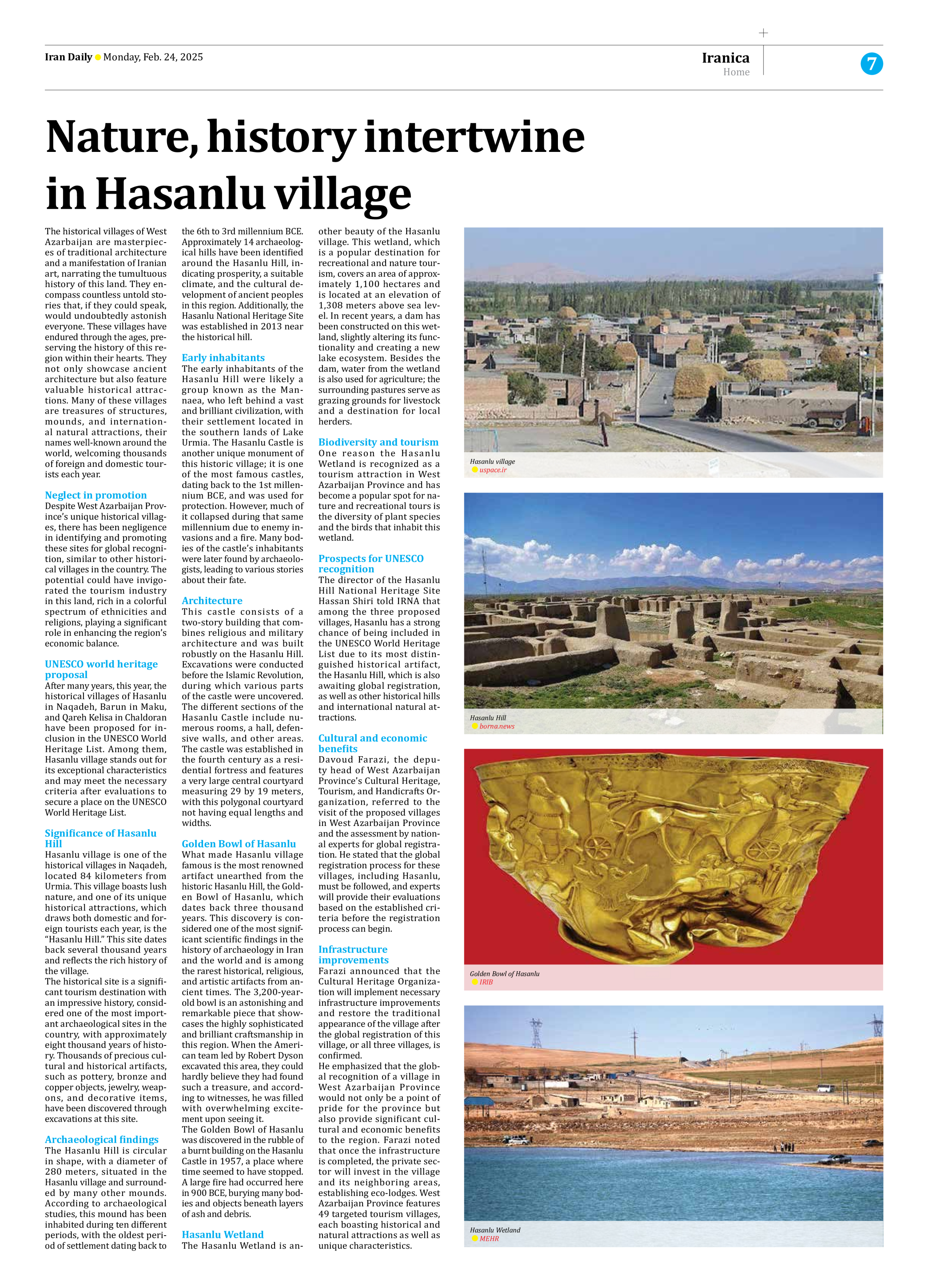
Nature, history intertwine in Hasanlu village
The historical villages of West Azarbaijan are masterpieces of traditional architecture and a manifestation of Iranian art, narrating the tumultuous history of this land. They encompass countless untold stories that, if they could speak, would undoubtedly astonish everyone. These villages have endured through the ages, preserving the history of this region within their hearts. They not only showcase ancient architecture but also feature valuable historical attractions. Many of these villages are treasures of structures, mounds, and international natural attractions, their names well-known around the world, welcoming thousands of foreign and domestic tourists each year.
Neglect in promotion
Despite West Azarbaijan Province’s unique historical villages, there has been negligence in identifying and promoting these sites for global recognition, similar to other historical villages in the country. The potential could have invigorated the tourism industry in this land, rich in a colorful spectrum of ethnicities and religions, playing a significant role in enhancing the region’s economic balance.
UNESCO world heritage proposal
After many years, this year, the historical villages of Hasanlu in Naqadeh, Barun in Maku, and Qareh Kelisa in Chaldoran have been proposed for inclusion in the UNESCO World Heritage List. Among them, Hasanlu village stands out for its exceptional characteristics and may meet the necessary criteria after evaluations to secure a place on the UNESCO World Heritage List.
Significance of Hasanlu Hill
Hasanlu village is one of the historical villages in Naqadeh, located 84 kilometers from Urmia. This village boasts lush nature, and one of its unique historical attractions, which draws both domestic and foreign tourists each year, is the “Hasanlu Hill.” This site dates back several thousand years and reflects the rich history of the village.
The historical site is a significant tourism destination with an impressive history, considered one of the most important archaeological sites in the country, with approximately eight thousand years of history. Thousands of precious cultural and historical artifacts, such as pottery, bronze and copper objects, jewelry, weapons, and decorative items, have been discovered through excavations at this site.
Archaeological findings
The Hasanlu Hill is circular in shape, with a diameter of 280 meters, situated in the Hasanlu village and surrounded by many other mounds. According to archaeological studies, this mound has been inhabited during ten different periods, with the oldest period of settlement dating back to the 6th to 3rd millennium BCE. Approximately 14 archaeological hills have been identified around the Hasanlu Hill, indicating prosperity, a suitable climate, and the cultural development of ancient peoples in this region. Additionally, the Hasanlu National Heritage Site was established in 2013 near the historical hill.
Early inhabitants
The early inhabitants of the Hasanlu Hill were likely a group known as the Mannaea, who left behind a vast and brilliant civilization, with their settlement located in the southern lands of Lake Urmia. The Hasanlu Castle is another unique monument of this historic village; it is one of the most famous castles, dating back to the 1st millennium BCE, and was used for protection. However, much of it collapsed during that same millennium due to enemy invasions and a fire. Many bodies of the castle’s inhabitants were later found by archaeologists, leading to various stories about their fate.
Architecture
This castle consists of a two-story building that combines religious and military architecture and was built robustly on the Hasanlu Hill. Excavations were conducted before the Islamic Revolution, during which various parts of the castle were uncovered. The different sections of the Hasanlu Castle include numerous rooms, a hall, defensive walls, and other areas. The castle was established in the fourth century as a residential fortress and features a very large central courtyard measuring 29 by 19 meters, with this polygonal courtyard not having equal lengths and widths.
Golden Bowl of Hasanlu
What made Hasanlu village famous is the most renowned artifact unearthed from the historic Hasanlu Hill, the Golden Bowl of Hasanlu, which dates back three thousand years. This discovery is considered one of the most significant scientific findings in the history of archaeology in Iran and the world and is among the rarest historical, religious, and artistic artifacts from ancient times. The 3,200-year-old bowl is an astonishing and remarkable piece that showcases the highly sophisticated and brilliant craftsmanship in this region. When the American team led by Robert Dyson excavated this area, they could hardly believe they had found such a treasure, and according to witnesses, he was filled with overwhelming excitement upon seeing it.
The Golden Bowl of Hasanlu was discovered in the rubble of a burnt building on the Hasanlu Castle in 1957, a place where time seemed to have stopped. A large fire had occurred here in 900 BCE, burying many bodies and objects beneath layers of ash and debris.
Hasanlu Wetland
The Hasanlu Wetland is another beauty of the Hasanlu village. This wetland, which is a popular destination for recreational and nature tourism, covers an area of approximately 1,100 hectares and is located at an elevation of 1,308 meters above sea level. In recent years, a dam has been constructed on this wetland, slightly altering its functionality and creating a new lake ecosystem. Besides the dam, water from the wetland is also used for agriculture; the surrounding pastures serve as grazing grounds for livestock and a destination for local herders.
Biodiversity and tourism
One reason the Hasanlu Wetland is recognized as a tourism attraction in West Azarbaijan Province and has become a popular spot for nature and recreational tours is the diversity of plant species and the birds that inhabit this wetland.
Prospects for UNESCO recognition
The director of the Hasanlu Hill National Heritage Site Hassan Shiri told IRNA that among the three proposed villages, Hasanlu has a strong chance of being included in the UNESCO World Heritage List due to its most distinguished historical artifact, the Hasanlu Hill, which is also awaiting global registration, as well as other historical hills and international natural attractions.
Cultural and economic benefits
Davoud Farazi, the deputy head of West Azarbaijan Province’s Cultural Heritage, Tourism, and Handicrafts Organization, referred to the visit of the proposed villages in West Azarbaijan Province and the assessment by national experts for global registration. He stated that the global registration process for these villages, including Hasanlu, must be followed, and experts will provide their evaluations based on the established criteria before the registration process can begin.
Infrastructure improvements
Farazi announced that the Cultural Heritage Organization will implement necessary infrastructure improvements and restore the traditional appearance of the village after the global registration of this village, or all three villages, is confirmed.
He emphasized that the global recognition of a village in West Azarbaijan Province would not only be a point of pride for the province but also provide significant cultural and economic benefits to the region. Farazi noted that once the infrastructure is completed, the private sector will invest in the village and its neighboring areas, establishing eco-lodges. West Azarbaijan Province features 49 targeted tourism villages, each boasting historical and natural attractions as well as unique characteristics.







